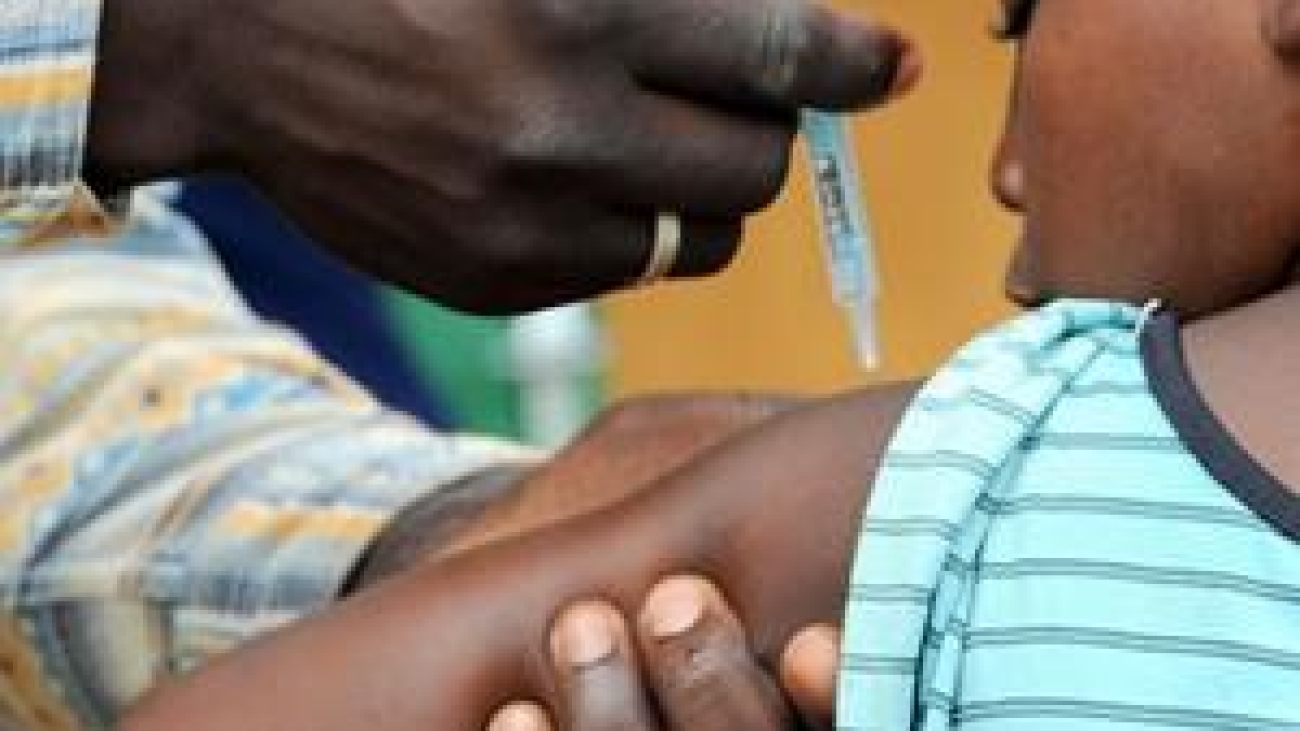Meningococcal meningitis is a bacterial form of meningitis, a serious infection of the meninges that affects the brain membrane. It can cause severe brain damage and is fatal in 50% of cases if untreated.
Several different bacteria can cause meningitis. Neisseria meningitidis is the one with the potential to cause large epidemics. There are 12 serogroups of N. meningitidis that have been identified, 6 of which (A, B, C, W, X and Y) can cause epidemics. Geographic distribution and epidemic potential differ according to serogroup.
Transmission
The bacteria are transmitted from person-to-person through droplets of respiratory or throat secretions from carriers. Close and prolonged contact – such as kissing, sneezing or coughing on someone, or living in close quarters (such as a dormitory, sharing eating or drinking utensils) with an infected person (a carrier) – facilitates the spread of the disease. The average incubation period is 4 days, but can range between 2 and 10 days.
Neisseria meningitidis only infects humans; there is no animal reservoir. The bacteria can be carried in the throat and sometimes, for reasons not fully understood, can overwhelm the body’s defenses allowing infection to spread through the bloodstream to the brain. It is believed that 10% to 20% of the population carries Neisseria meningitidis in their throat at any given time. However, the carriage rate may be higher in epidemic situations.
Symptoms
The most common symptoms are a stiff neck, high fever, sensitivity to light, confusion, headaches and vomiting. Even when the disease is diagnosed early and adequate treatment is started, 5% to 10% of patients die, typically within 24 to 48 hours after the onset of symptoms. Bacterial meningitis may result in brain damage, hearing loss or a learning disability in 10% to 20% of survivors. A less common but even more severe (often fatal) form of meningococcal disease is meningococcal septicaemia, which is characterized by a haemorrhagic rash and rapid circulatory collapse.
Diagnosis
Initial diagnosis of meningococcal meningitis can be made by clinical examination followed by a lumbar puncture showing a purulent spinal fluid. The bacteria can sometimes be seen in microscopic examinations of the spinal fluid. The diagnosis is supported or confirmed by growing the bacteria from specimens of spinal fluid or blood, by agglutination tests or by polymerase chain reaction (PCR). The identification of the serogroups and susceptibility testing to antibiotics are important to define control measures.
Treatment
Meningococcal disease is potentially fatal and should always be viewed as a medical emergency. Admission to a hospital or health centre is necessary, although isolation of the patient is not necessary. Appropriate antibiotic treatment must be started as soon as possible, ideally after the lumbar puncture has been carried out if such a puncture can be performed immediately. If treatment is started prior to the lumbar puncture it may be difficult to grow the bacteria from the spinal fluid and confirm the diagnosis.
A range of antibiotics can treat the infection, including penicillin, ampicillin, chloramphenicol and ceftriaxone. Under epidemic conditions in Africa in areas with limited health infrastructure and resources, ceftriaxone is the drug of choice.
Prevention
There are 3 types of vaccines available.
- Polysaccharide vaccines have been available to prevent the disease for over 30 years. Meningococcal polysaccharide vaccines are available in either bivalent (groups A and C), trivalent (groups A, C and W), or tetravalent (groups A, C, Y and W) forms to control the disease.
- For group B, polysaccharide vaccines cannot be developed, due to antigenic mimicry with polysaccharide in human neurologic tissues. The first vaccine against NmB, made from a combination of 4 protein components, was released in 2014.
- Since 1999, meningococcal conjugate vaccines against group C have been available and widely used. Tetravalent A, C, Y and W conjugate vaccines have been licensed since 2005 for use in children and adults in Canada, the United States of America, and Europe.
The extended meningitis belt of sub-Saharan Africa, stretching from Senegal in the west to Ethiopia in the east (26 countries), has the highest rates of the disease. The 26 countries include: Benin, Burkina Faso, Burundi, Cameroon, Central African Republic, Chad, Côte d’Ivoire, Democratic Republic of Congo, Eritrea, Ethiopia, The Gambia, Ghana, Guinea, Guinea Bissau, Kenya, Mali, Mauritania, Niger, Nigeria, Rwanda, Senegal, South Sudan, Sudan, Tanzania, Togo and Uganda. The risk of meningococcal meningitis epidemics differs within and among these 26 countries.
In December 2010, a new meningococcal A conjugate vaccine was introduced nationwide in Burkina Faso, and in selected regions of Mali and Niger (the remaining regions were covered in 2011), targeting persons 1 to 29 years of age. As of June 2015, 220 million persons have been vaccinated with this vaccine in 16 countries (Benin, Burkina Faso, Cameroon, Chad, Côte d’Ivoire, Ethiopia, The Gambia, Ghana, Guinea, Mali, Mauritania, Niger, Nigeria, Senegal, Sudan, and Togo).
The MenA conjugate vaccine has several advantages over existing polysaccharide vaccines:
- it induces a higher and more sustainable immune response against group A meningococcus;
- it reduces the carriage of the bacteria in the throat and thus its transmission;
- it is expected to confer long-term protection not only for those who receive the vaccine, but on family members and others who would otherwise have been exposed to meningitis;
- it is available at a lower price than other meningococcal vaccines (around 0.50 USD per dose, other meningococcal vaccine prices range from 2.50 USD to 117.00 USD per dose); and
- it is expected to be particularly effective in protecting children under two years of age, who do not respond to conventional polysaccharide vaccines.
In addition, its thermostability allows for a use under Controlled Temperature Chain (CTC) conditions. More than 2 million persons in 4 countries have been vaccinated without ice use at the vaccination site.
It is planned that all 26 African countries considered at risk for meningitis epidemics and targeted by this vaccine introduction programme will have introduced this vaccine by 2016. High coverage of the target age group of 1–29 years is expected to eliminate meningococcal A epidemics from this region of Africa.
Outbreak trends
Meningococcal meningitis occurs in small clusters throughout the world with seasonal variation and accounts for a variable proportion of epidemic bacterial meningitis.
The largest burden of meningococcal disease occurs in an area of sub-Saharan Africa known as the meningitis belt, which stretches from Senegal in the west to Ethiopia in the east. During the dry season between December to June, dust winds, cold nights and upper respiratory tract infections combine to damage the nasopharyngeal mucosa, increasing the risk of meningococcal disease. At the same time, transmission of N. meningitidis may be facilitated by overcrowded housing and by large population displacements at the regional level due to pilgrimages and traditional markets. This combination of factors explains the large epidemics which occur during the dry season in the meningitis belt.
Following the successful roll-out of the MenA conjugate vaccine, epidemics due to N. meningitidis serogroup A are disappearing, but other meningococcal serogroups such as NmW, NmX and NmC still cause epidemics albeit at a lower frequency and smaller size.
Source : WHO
Photo Credit: SundiataPost


